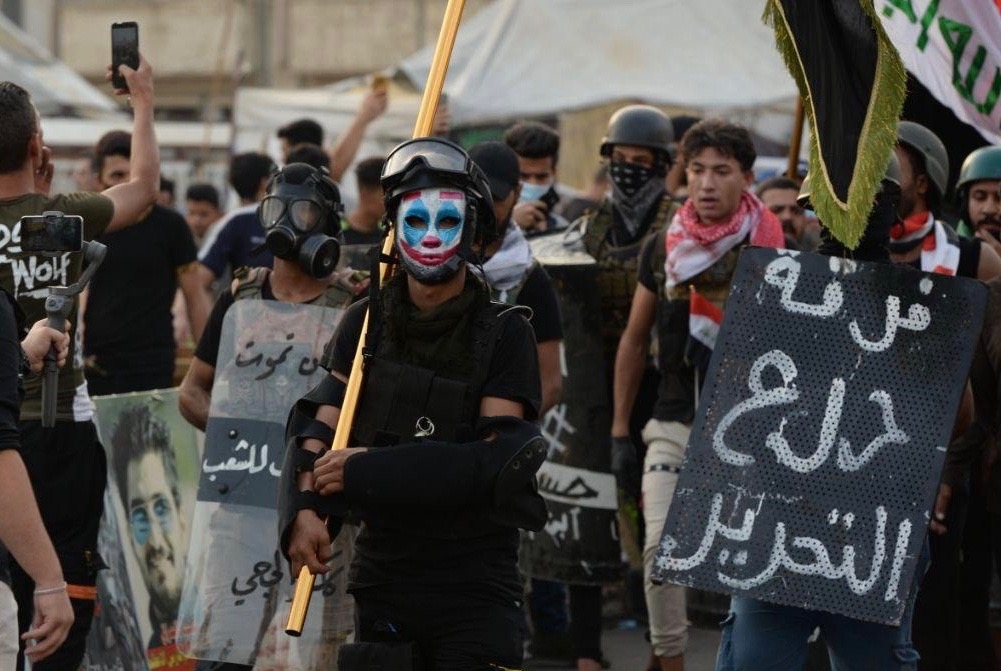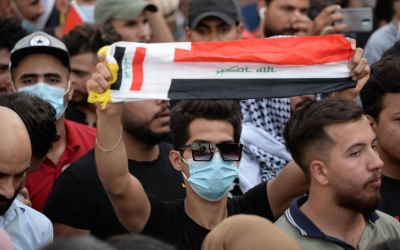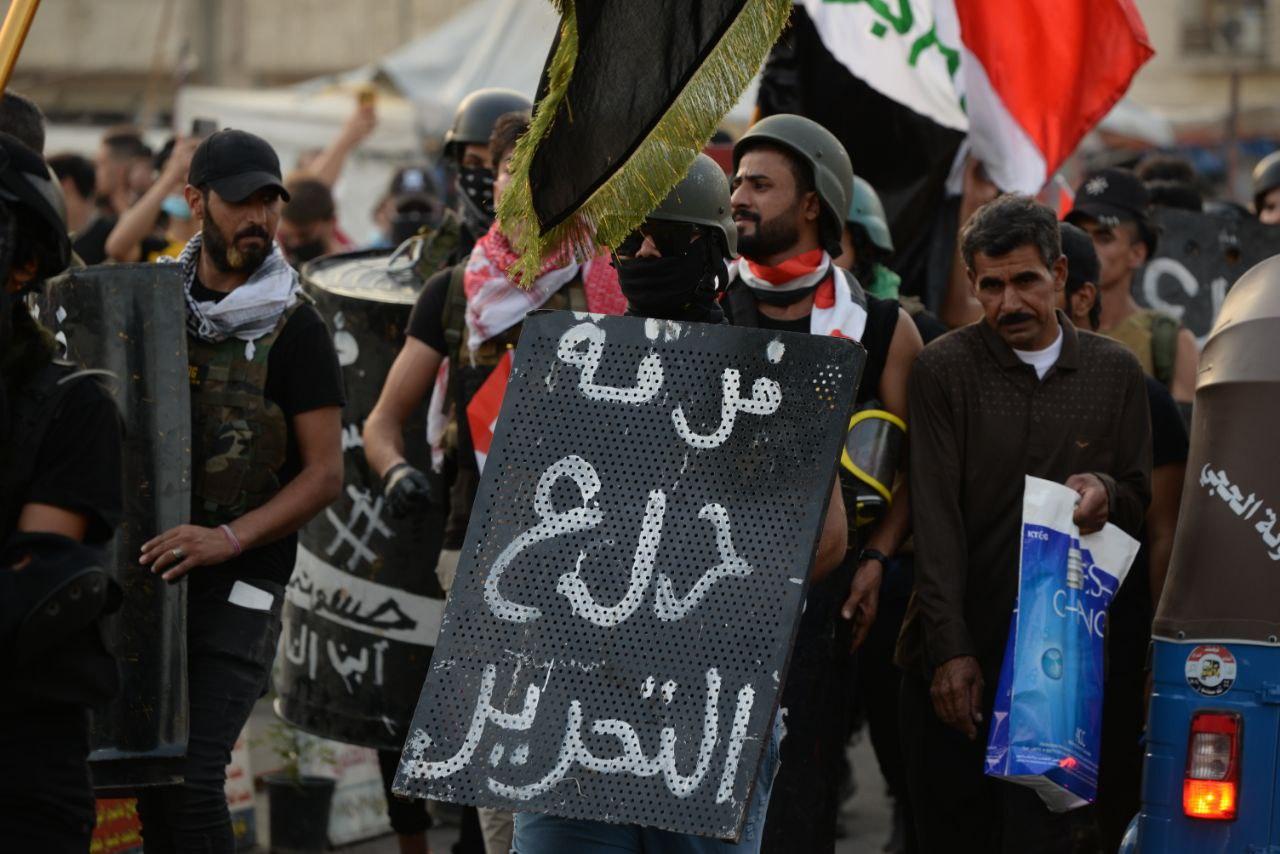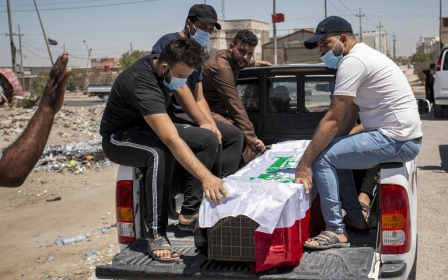The young Iraqis protecting protesters from deadly crackdowns

Among the protesters in Tahrir Square walks a group of young shield-wielding Iraqis on the lookout for any signs of trouble, relying on instincts tried and tested by one year of anti-government demonstrations.
They call themselves Al-Tahrir Shield.
Last year, around 50 protesters decided to join forces to protect and shield fellow demonstrators from the brutality of security forces in their attempts to quash the protest movement, now in its second year.
The group has become the buffer force that aims to defend protesters, helping them avoid teargas canisters, which are employed in abundance in Tahrir Square and nearby areas and have proven deadly in numerous cases.
In extreme cases, when security forces charged on protest areas, members would throw molotov cocktails in order to create a fire barrier to give time for others to either escape or stay a while longer.
New MEE newsletter: Jerusalem Dispatch
Sign up to get the latest insights and analysis on Israel-Palestine, alongside Turkey Unpacked and other MEE newsletters
Al-Tahrir Shield says that one of its goals is to prevent any more bloodshed while the movement attempts to achieve all of its demands.
In October last year, Iraqis from all walks of life descended on the streets of the capital Baghdad and across southern provinces to demand the fundamental rights they have been deprived of by successive governments for nearly two decades.
They are also calling for an overhaul of the political system, an amendment of the electoral law and early elections aimed at ousting a corrupt layer of officials.
But instead of reforms and a crackdown on corruption, authorities employed violent and unlawful tactics aimed at quashing the unrest, including the use of live ammunition, teargas, hot water, seizing protesters from squares and homes, and setting fire to protest tents.
Militias have targeted the protesters, too. On Tuesday influential Shia cleric Muqtada al-Sadr issued a statement calling the protesters Baathists and Islamic State group sympathisers, and threatening to unleash his many armed followers on them.
Overall, at least 560 protesters were killed in the protests, while targeted assassinations have killed 64 protesters and activists, according to Ali al-Bayati, a member of the Iraqi High Commission for Human Rights.
Shields made in squares
Members of Al-Tahrir Shield make their defensive tools in Tahrir Square, the hub of the protest movement in central Baghdad, by using simple, makeshift materials.
For instance, one body shield was made from an old oil barrel cut in half; others, including a face shield, were made from scraps of metal or satellite dishes.
The young activists are mostly from Baghdad, but some have come from other Iraqi provinces to volunteer in Al-Tahrir Shield’s mission around the protest hotspots in the capital.
Protesters in Tahrir Square see the group as a human wall in the face of further escalations or clashes between security forces and themselves.
A campaign of assassinations and kidnapping of protesters and activists in Baghdad and other southern cities by armed groups have led Al-Tahrir Shield members to be excessively cautious out of fear of being targeted themselves.
As a result, they have chosen anonymity and call each other by nicknames, such as Theeb al-Sinak (The Wolf of Sinak) - after one of the bridges closed by protests - and Dukkhaniya, which means teargas canister.
The group meets near the square in a members-only tent.
“My friends and I decided to form this group due to the lethal force we have faced since the protests started in 2019,” Theeb al-Sinak, 26, tells Middle East Eye.
“Our mission is to divert the danger from protesters, and transfer the wounded to the nearest healthcare centres to the square.”
Theeb al-Sinak says the team is distributed between Tahrir Square, al-Khayyam Street, al-Jumhuriya Bridge, al-Khilani Square, a-Wathba Square, Muhammad Al-Qasim Street.
But, he says, Al-Tahrir Shield “will be available everywhere there is need for us”.
“We donate money from our own pockets to buy the things we need, like gloves, masks, or anything we cannot make with our hands,” he adds.
The group also receives donations from families to continue with the protests, and Theeb al-Sinak says the group is thankful.
A warm welcome
On 1 October, when the protest movement was marking its first anniversary, the group marched through al-Tayyaran tunnel and received a warm welcome from protesters.
'Our mission is to divert the danger from protesters, and transfer the wounded to the nearest healthcare centres to the square'
- Theeb al-Sinak, Al-Tahrir Shield member
“It was a good idea to form this group as we face all kinds of weapons used by security forces,” Ayham Askar, a 19-year-old protester, tells MEE, thanking the group for their efforts.
“I hope other Iraqi provinces copy the idea and form their own groups to protect themselves too.”
Askar is one of thousands of Iraqis who decided to take to the streets again, after a long pause due to the coronavirus pandemic, to call for the protest movement's demands to be addressed.
“Since the first day of the 2019 movement until today, I have stayed here in the square, which is no longer just a square, but has become a home for all Iraqi,” the young protester says.
“There are no words to describe how happy I am to see flags of Iraq flutter again, and the lights turned on.”
Near Tahrir Square, MEE spoke to 17-year-old Ali al-Bawi, who says he got interested in being involved with Al-Tahrir Shield when he saw their march in the square.
“It would be my honour to protect the squares. It is a patriotic duty for every demonstrator to help protect each other,” Bawi says.
Protesters have given Prime Minister Mustafa al-Kadhimi, appointed in May, until 25 October to meet their demands.
Al-Tahrir Shield, meanwhile, is preparing to face any possible crackdown by security forces.
“We are inventing ways to protect ourselves, which is the government's duty, but unfortunately... the government is unable to protect itself...So how can they protect the squares?” Bawi says.
Middle East Eye delivers independent and unrivalled coverage and analysis of the Middle East, North Africa and beyond. To learn more about republishing this content and the associated fees, please fill out this form. More about MEE can be found here.






